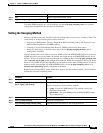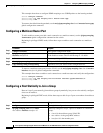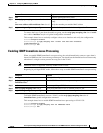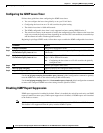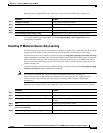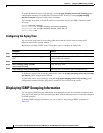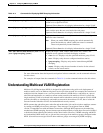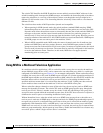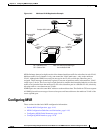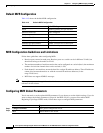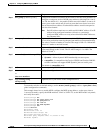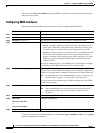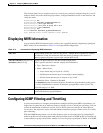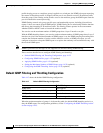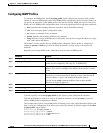
14-16
Cisco Systems Intelligent Gigabit Ethernet Switch Modules for the IBM BladeCenter, Software Configuration Guide
24R9746
Chapter 14 Configuring IGMP Snooping and MVR
Understanding Multicast VLAN Registration
The switch CPU identifies the MVR IP multicast streams and their associated MAC addresses in the
switch forwarding table, intercepts the IGMP messages, and modifies the forwarding table to include or
remove the subscriber as a receiver of the multicast stream, even though the receivers might be in a
different VLAN from the source. This forwarding behavior selectively allows traffic to cross between
different VLANs.
The switch has these modes of MVR operation: dynamic and compatible.
• When operating in MVR dynamic mode, the switch performs standard IGMP snooping. IGMP
information packets are sent to the switch CPU, but multicast data packets are not sent to the CPU.
Dynamic mode allows the multicast router to run normally because the switch sends the IGMP join
messages to the router, and the router forwards multicast streams for a particular group to an
interface only if it has received a join message from the interface for the group. Receiver ports are
treated as members of the multicast VLAN for MVR multicast control and data traffic. IGMP reports
for MVR groups are sent out source ports in the multicast VLAN.
• When in MVR compatible mode, MVR works the same as dynamic mode for all multicast data
packets and IGMP query and leave packets. However, received IGMP report packets for MVR
groups are not sent out on the multicast VLAN source ports. In contrast to dynamic mode, the switch
does not send join messages to the router. The router must be statically configured for the interface
to receive the multicast stream. Therefore, in this mode, MVR does not support dynamic
membership joins on source ports.
Note IGMPv3 join and leave messages are not supported on switches running MVR.
Using MVR in a Multicast Television Application
In a multicast television application, a PC or a television with a set-top box can receive the multicast
stream. Multiple set-top boxes or PCs can be connected to one subscriber port, which is a switch port
configured as an MVR receiver port. Figure 14-3 is an example configuration. When a subscriber selects
a channel, the set-top box or PC sends an IGMP report to Switch A to join the appropriate multicast. If
the IGMP report matches one of the configured multicast MAC addresses, the switch CPU modifies the
hardware address table to include this receiver port and VLAN as a forwarding destination of the
specified multicast stream when it is received from the multicast VLAN. Uplink ports that send and
receive multicast data to and from the multicast VLAN are called MVR source ports.
When a subscriber changes channels or turns off the television, the set-top box sends an IGMP leave
message for the multicast stream. The switch CPU sends an IGMP group-specific query through the
receiver port VLAN. If there is another set-top box in the VLAN still subscribing to this group, that
set-top box must respond within the maximum response time. If the CPU does not receive a response, it
eliminates the receiver port as a forwarding destination for this group.
Without Immediate Leave, when the switch receives an IGMP leave message from a subscriber on a
receiver port, it sends out an IGMP query on that port and waits for IGMP group membership reports. If
no reports are received in a configured time period, the receiver port is removed from multicast group
membership. With Immediate Leave, an IGMP query is not sent from the receiver port on which the
IGMP leave was received. As soon as the leave message is received, the receiver port is removed from
multicast group membership, which speeds up leave latency. Enable the Immediate Leave feature only
on receiver ports to which a single receiver device is connected.




